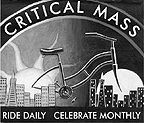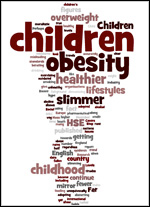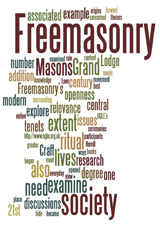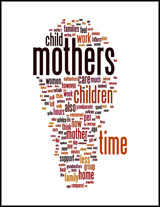“We ARE traffic!”
— Critical Mass and the politicisation of the bicycle.
"The 'org' domain notwithstanding, Critical Mass is not an organisation, it's an unorganised coincidence. It's a movement … of bicycles, in the streets." (www.critical-mass.org)
Critical Mass has existed as an "unorganised coincidence" since the early nineties, when a group of cyclists in San Francisco decided to cycle home from work en masse on the last Friday of every month. The initial numbers involved were small — around 45-50 attending the first rides — but the movement (if it can be called this) has blossomed into a world-wide phenomenon, with rides across the globe attracting thousands of cyclists and Critical Mass itself becoming a symbol of successful, peaceful protest. However, the word "protest" is a loaded one, and despite the significant presence of Critical Mass cyclists at events like anti-capitalist May Day protests and marches against the 2003 Iraq war, Critical Mass literature is keen to emphasise the lack of dogmatic ideology behind the rides themselves. As Chris Carlsson, one of the founders of the San Francisco CM, puts it:
"It is inherently anti-corporate even though there are more uncritical supporters of the American Empire and its moneyed interests riding along than there are blazing subversives, which is just another of the many pleasant ironies of Critical Mass."
Indeed, Critical Mass websites (of which there are many, with no one site acting as a main resource or homepage) emphasise the idea of a "Xerocracy" between cyclists, in that anyone can bring printed materials — flyers, pamphlets etc — to distribute at a Critical Mass ride without the content of this material being seen to be entirely representative of Critical Mass itself. This emphasises further the idea that nothing, beyond riding bikes in large groups, actually represents Critical Mass thinking. There are as many ideologies as there are cyclists on the rides, which makes Critical Mass simple to become a part of and yet difficult to define.
While Critical Mass rides clearly have something to say about the car-dominated state of transport systems, it would be wrong to categorise CM as an "anti-car" movement. Many of those who attend the rides also drive cars on other days, while some of those held up in cars at intersections by CM rides will also be keen cyclists. The essence of CM, if such a thing can be spoken of, goes beyond the idea of simple transport and holds the bicycle up as a symbol of a different world, a contrasting mode of existence to that represented and dominated by the car. To quote Carlsson again:
"When I bicycle around town I see things happening and can stop and explore them in depth with no hassles. I also see my friends and acquaintances and can stop and speak with them directly. This, combined with the absence of mass media pumping into my brain in the isolation of my car, sets up organic links and direct channels of human experience and communication." (Carlsson, "Bicycling Over the Rainbow")

"Cars have no solution for humanity. Cars offer only death, domination and convenience, and cold detachment to the human heart and mind."
However, when we compare the sexualised imagery of "Death, Domination and Convenience" with the following, slightly more sedate expression of love for the bicycle, it is clear that any object can be fetishised and prized beyond its worth if its user sees fit:
"I can't see but that a wheel is just as good company as most husbands two years old. I would lief as talk to one inanimate object as another, and I'd rather imagine a sympathetic response in a bright and shining handlebar than know it doesn't exist in a frowning man, who yawns or starts when I ask him a question." (Ann Strong, Minneapolis Tribune 1859. See David Perry's "The Political Tool" at www.chicagocriticalmass.org)
If 19th century ladies were genuinely prizing bikes over husbands, then it is hardly surprising that the bicycle has gained a reputation as a vehicle of social change and egalitarianism. On a more serious note, the bicycle has played a significant role in the construction and maintenance of political regimes — for instance in communist China and also in Cuba. Jose Antonio Viera Gallo, a Chilean Secretary for Justice, is quoted as saying: "Socialism can only come riding a bicycle." (David Perry, "The Political Tool")
However, those who would wish to portray the bicycle purely as a tool of socialism would do well to remember 1937 Nazi propaganda campaigns featuring a film called "The Day of the German Cyclist". It is clear that the politicisation of the bicycle can be viewed from all areas of the political spectrum — to hold up the bike as a symbol of egalitarianism is perhaps just as much folly as it is to argue that most men get a sexual kick from filling up their cars at petrol stations.
The loaded symbolism that is associated with the car and the bicycle, and any perceived conflict between the two, is basically irrational. However, it exists, and this is what makes Critical Mass a successful, if amorphous and undefinable, movement. The success of the car will always be associated with the oil industry, overconsumption, laziness, isolated individualism and everything that is perceived to be bad about "Western" culture. Against this backdrop, cycling comes across as an anarchistic, perhaps slightly dangerous, but also an ultimately friendly activity, one which requires a different conception of city space from that of the car user. Re-emphasis of the ideals of community and responsibility, along with emphasis on common perception of public space, can only be a positive and useful thing, and if it comes in the shape of a lot of cyclists, so be it. To paraphrase George Orwell, "Two wheels good, Four wheels bad" is a dogmatic and nonsensical principle. Critical Mass, for all its vagueness, does well to realise this by always treating cycling as a means of generating dialogue about social change, rather than as an end in itself. To quote Chris Carlsson for a final time:
"…today's bike advocates tend to view the bicycle as something that is inherently superior, that brings about social changes all by itself, endowing it with causal qualities that ought to be reserved for human beings .I greatly appreciate the bicycle for its functionality in short-circuiting dominant social relations, but lets not forget that it is merely another tool, and has no will of it's own." (Carlsson, "Bicycling Over the Rainbow")





